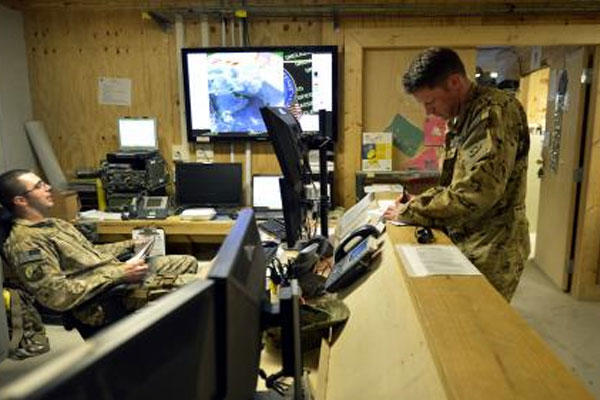MAZAR-E-SHARIF, Afghanistan -- When people hear the term "weatherman" they typically think of a person dressed in business attire providing the latest hurricane update or winter storm warning on the evening news.
The battlefield airmen of the 19th Expeditionary Weather Squadron couldn't be further from that image. Dressed in camouflage patterned uniforms and embedded with Army tactical operations centers, they are in charge of providing timely and accurate environmental intelligence to service members throughout Afghanistan.
Located in Mazar-E-Sharif, three airmen, Master Sgt. Brian Landrum, Staff Sgt. Mickey Steppe and Senior Airman Michael Richardson, share the duties of providing Army pilots with weather using one weather sensor and radar. On MEZ, the 19th EWXS here supports the Army 135th Attack Reconnaissance Battalion deployed from St. Louis.
"The pilots and other soldiers put their trust in us (battlefield weather forecasters) to give them timely and accurate forecasts, and if I slack off, it could potentially put them in danger," said Richardson, night weather forecaster deployed from Fort Riley, Kan., and a native of Baltimore.
When it comes to air operations, weather can determine if a sortie can be launched. Low visibility, storms and strong winds are just a few conditions that can limit which air assets are available to support ground operations. Much of Afghanistan is comprised of mountainous areas, typically a more dynamic weather environment than flat terrain.
"Our main mission is to get accurate data not only for here, but for any place that they could be going, and make sure that they are routed around anything that might hinder their flight, and that when they get to where they're going they have the right kind of weather to accomplish their mission," said Steppe, deployed from Virginia Air National Guard Headquarters and native of Richmond, Va.
The weather team on MEZ uses radar and a Tactical Meteorological Observing System to predict forecast. Recently, all the radar and sensors on MEZ were replaced with a new system. Landrum who was deployed to this same base 16 months ago worked with the old system.
Landrum, deployed from Joint Base Lewis-McCord, Wash., and a native of Temecula, Calif., concluded, "We are transferring the prior weather system to the Afghan National Army because they currently have no weather forecast capabilities."





























